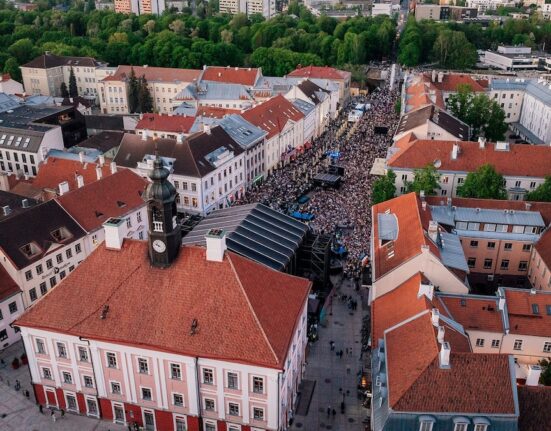Since the first missiles landed on Ukraine, military support from Western allies has been a pillar of Ukraine’s defence against Russia’s full-scale invasion. But while there has been a significant increase in munitions production in the United States and the European Union, the military warehouses of Western allies are not bottomless, nor is the political will and funds to finance them. And, the recent outbreak of war in Gaza has only added to the strain on Western support. Moreover some European countries have realised that it is more pragmatic to keep their own military in good shape rather than sending their equipment in military aid.
Thus, to ensure longevity in the support for Ukraine’s army, the West should expand its own arms production while also investing in Ukraine’s military-industrial capabilities to boost its military self-sufficiency – and Europe’s long term security.
Investing in Ukraine’s military capabilities
Early signs of Western support for Ukrainian military production were seen at the first International Defence Industries Forum in Kyiv in September, which brought together 252 weapon-producers from 31 countries. Subsequently, 20 agreements were signed and 59 companies joined the newly-established Alliance of Defence Industries. While all parties kept silent on the details of the agreements for operational security reasons, the demands made by the AFU at the forum revealed their three most urgent needs.
1. Artillery
Stable and sufficient provision of artillery shells is crucial to the AFU’s ability to conduct offensive operations. On average, the Ukrainian forces are firing around 110,000 155mm shells per month, but the minimum needed to execute successful battle plans is almost three times higher, at 360,000 shells per month. Currently the US produces 28,000 155mm-calibre rounds per month and EU countries produce nearly 25,000 rounds per month. While Western allies plan to triple their production of the artillery rounds in the near future, this increase would still be insufficient to cover the AFU’s minimum needs.
It would therefore be practical for the EU to further its engagement with the Ukrainian state-owned military manufacturer Ukroboronprom on its artillery shells production enlargement programme. So far, Ukroboronprom has been active in developing joint capabilities with European partners. For example, it announced plans in June to develop the production of 155mm shells to an estimated 20,000-30,000 shells per month, alongside other military equipment, in cooperation with Germany’s Rheinmetall. In May, Rheinmetall also announced that it will consider jointly producing air defence machinery and ammunition with Ukroboronprom. Similar discussions were recently initiated by Ukroboronprom with France and the United Kingdom’s BAE Systems. And, earlier this year, Ukroboronprom and the state-owned Polish Armament Group announced that they will establish a joint production of 125mm rounds for Soviet-era tanks, which are in high demand for Ukraine’s counter offensive operations. Should these plans be realised, it will substantially enhance Ukrainian military capabilities, as well as support the economies of both partners.
Going forward, the EU and UK’s engagement with Ukroboronprom should be streamlined through one platform to coordinate a steady increase of Ukraine’s own artillery munition production, building up to self-sufficiency. Rather than a mosaic of different Western companies’ attempts to expand their arms markets, engagement with Ukroboronprom should represent a logical and comprehensive strategy to underpin Ukraine’s defence capabilities. In doing so, Ukroboronprom could became a manufacturing hub for Western artillery shell producers.
2. Long-range weapons
Ukraine needs long-range weapons to erode Russia’s munition and fuel stockpiles far behind the frontlines. This is essential for the AFU’s advancement. The UK and France have already supplied Kyiv with Storm Shadow and SCALP cruise missiles, which the AFU have successfully used. But, Germany still hesitates to provide Ukraine with Taurus cruise missiles, and the US only recently made a decision on supplying long-range ATACMS ballistic missiles which Ukraine had asked for since mid-2022.
This reluctance hints at the political difficulties Western allies face when providing long-range weapons to Ukraine, particularly over debates on the escalation risk that comes with direct engagement in the war. While there was no clear Russian escalation after supplying Ukraine with missiles, Western countries should nevertheless focus on helping Ukraine build its own long-range weapons program. This would reduce both the escalation risk and Ukraine’s reliance on limited Western supplies.
Ukraine already cooperates with some foreign countries on missile production, and Kyiv has announced some successful use of domestic-made long-range missiles against Russian forces. However, based on information from open sources, these are not yet mass produced. In the meantime, increasing the West’s missile production for Ukraine is needed to maintain its defence capabilities. But, longer term solutions should also be embraced to support Ukraine’s transition to production self-sufficiency. This could include Ukrainian-Western joint enterprises, co-production and co-financing. And similar to the approach with artillery, this should be coordinated amongst Western allies to ensure a synergy of Western engagement. For instance, streamlined access to Western technological resources and financial investment may be crucial for getting the long-awaited development of the Ukrainian tactical missile system Hrim-2 off the ground.
Increasing the West’s missile production for Ukraine is needed to its maintain defence capabilities. But, longer term solutions should also be embraced to support Ukraine’s transition to production self-sufficiency
3. Drones
Unmanned aerial vehicles (UAV) continue to play a crucial role in the war as a weapon, a reconnaissance tool, and for providing useful material for propaganda purposes. Promisingly, Ukraine has been quick to develop its industry in this sector: the number of private drone manufacturers in the country has grown from 7 to 80 in under a year. State manufacturers, together with Western partners, have also been quick to adapt. Most notably, Ukrainian company Antonov opened a new drone centre in September and announced plans to enhance its UAV manufacturing capabilities in cooperation with France’s Turgis and Gaillard. And, the old UAV producing partner of Ukraine, Turkish Baykar, has already started building a production unit in Ukraine which will include an assembly line, composites, and a planned engine unit. However, it will take more than a year to complete.
Despite these steps in the right direction, Ukraine’s drone production needs to be strengthened, especially considering Russia has started producing its own version of the powerful Iranian Shahed drone. Therefore, joint production of drones with attack systems will be crucial for Ukraine’s ability to retaliate against Russian strikes. Despite Ukraine’s well-established drone production partnerships, extending it new partners is essential for diversifying its UAV arsenal. And, because requirements on drone production are not as rigid, there is more room for expansion than in other military industries. In doing so, Western companies, together with their Ukrainian counterparts, should continue to invest in developing new drone technology to strengthen the AFU’s abilities, reduce reliance on Western drone supplies, and encourage the development of cutting-edge drone capabilities in Europe, the US, and Ukraine.
Arming Ukraine for the long war
Russia’s war continues to push Ukraine to reshape and reinvent its military industrial capabilities. Considering the limited ability and will of its partners to ramp up their military production for Ukraine, the US and Europe should focus on strengthening the domestic capabilities of Ukraine to produce arms. This strategy can be beneficial to all sides involved: while Ukraine will be able to cover its most urgent military needs, its partners will be able to develop their domestic military industries for their own sake, and avoid some domestic political tensions over their engagement with the war.
At present, neither Ukraine’s domestic arms production nor the capacity of Western military support is enough to cover the AFU’s needs. Instead, the most appropriate path to fulfil Ukraine’s defence needs, and potentially lead to the sustainable growth of Ukraine’s armed forces capabilities to turn the tide of war, lies in the support Western partners provide Ukraine to help develop its own industry, starting with joint production and investment. This will eventually supplement Western military aid and create a more politically and financially stable supply chain to arm the Ukrainian defence Considering Russia’s attempts to prolong the war, the ability of Ukraine to sustain itself by producing long-range missiles, shells, drones, and other weapons that require mass production, would be decisive. In the short run, it will help meet the ammunition needs of the Ukrainian army, while in the long run, it will strengthen the defence capabilities of Ukraine and its partners and ensure a more secure European future.
The European Council on Foreign Relations does not take collective positions. ECFR publications only represent the views of their individual authors.






